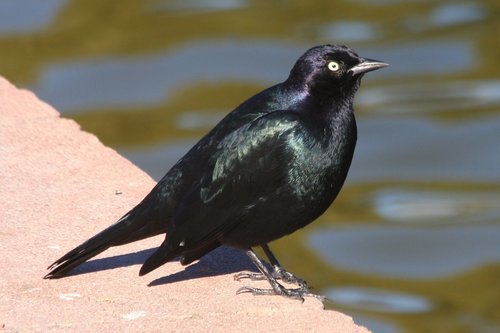
Brewer's Blackbird
The Brewer's Blackbird (Euphagus cyanocephalus) is a medium-sized New World blackbird, common across western and central North America. Known for its adaptability, it thrives in a variety of habitats, from grasslands and agricultural fields to urban parks. Males are easily recognized by their glossy black plumage and striking yellow eyes, while females are a more subdued brown. This species plays a significant role in insect control, consuming large quantities of agricultural pests. While not currently considered threatened, their populations have experienced some declines due to habitat loss and pesticide use. They are not culturally significant.
19-25 cm
Length
37-40 cm
Wingspan
Least Concern
Conservation Status
Distribution
Brewer's Blackbirds are found across western and central North America. Their breeding range extends from British Columbia and Alberta in Canada, south through the western United States to Baja California, and east to the Great Lakes region. During winter, they migrate south, with some populations reaching central Mexico.
Lifespan
Up to 12 years in the wild, though the average lifespan is likely shorter.
Brewer's Blackbird's Habitat
Habitat Types
Grasslands, Agricultural fields, Urban parks, Open woodlands, Marshes, Meadows
Climate Zones
Temperate, Subtropical
Adaptations
Brewer's Blackbirds are highly adaptable to various habitats. Their strong legs and feet allow them to forage effectively on the ground, and their generalist diet enables them to thrive in diverse environments.
Variations
While two subspecies have been proposed, they are not widely recognized, and variation is largely clinal, with birds in the Great Basin being slightly larger and longer-billed.
Appearance
Breeding Plumage
Breeding males have glossy black plumage with iridescent purple and green hues, while females are a dull brownish-gray. Non-breeding males may have some brown feather edges, and females remain brownish-gray.
Seasonal Feather Changes
Plumage is brightest during the breeding season. After molting in late summer, the plumage becomes slightly duller.
Sex Based Plumage Differences
Significant sexual dimorphism exists, with males being glossy black and females being brownish-gray.
Notable Features
Bright yellow eyes in males, Dark eyes in females, Long, pointed bill
Diet and Feeding
Primary Foods
Insects, Seeds, Grains, Small fruits, Occasionally, small invertebrates
Foraging Behavior
Brewer's Blackbirds primarily forage on the ground, walking or running while searching for food. They often flip over objects or probe the soil with their bills. They also glean insects from foliage and sometimes catch insects in flight.
Specializations
Their strong legs and feet are well-suited for ground foraging. Their bill is versatile, allowing them to consume a variety of food items.
Seasonal Diet Variations
During the breeding season, their diet is primarily insects. In the fall and winter, they shift to consuming more seeds and grains.
Behavior
Social Structure
Highly social, especially outside of the breeding season, when they form large flocks. During the breeding season, they may nest in loose colonies.
Communication
A variety of calls, including a sharp 'check' call, A complex song consisting of gurgles, clicks, and whistles, Visual displays, such as fluffing feathers and spreading wings
Migration
Many populations are migratory, moving south for the winter. Others are resident year-round, particularly in coastal areas.
Territorial or Group Behaviors
Males defend small territories around their nests during the breeding season. Outside of the breeding season, they are highly gregarious and form large foraging and roosting flocks.
Conservation
Threats
Habitat loss due to agriculture and urbanization, Pesticide use, which can reduce insect prey and directly poison birds, Climate change, which may alter habitat suitability
Protection Programs
General wildlife conservation efforts that protect habitat, Regulations on pesticide use
Local National Laws
Protected under the Migratory Bird Treaty Act in the United States and Canada.
Population Trend
Decreasing
Population Estimates
Estimated at 26 million individuals.
Interesting Facts
They often forage in mixed-species flocks with other blackbirds and starlings.
This behavior may provide increased protection from predators and improved foraging efficiency.
Brewer's Blackbirds are known to follow plows and other agricultural machinery to feed on exposed insects and seeds.
This demonstrates their adaptability to human-altered landscapes.
They can sometimes be seen bathing in puddles or shallow water.
This helps them keep their feathers clean and in good condition.
Faqs about Brewer's Blackbird
What do Brewer's Blackbirds eat?
They eat a variety of insects, seeds, and grains. Their diet varies seasonally, with insects being more important during the breeding season.
Where do Brewer's Blackbirds nest?
They build cup-shaped nests in a variety of locations, including trees, shrubs, and on the ground, often in loose colonies.
Are Brewer's Blackbirds aggressive?
Males can be aggressive during the breeding season when defending their territories. Otherwise, they are generally not aggressive towards humans.
How can I tell the difference between a male and female Brewer's Blackbird?
Males are glossy black with yellow eyes, while females are a dull brownish-gray with dark eyes.
Copyright @ Nature Style Limited. All Rights Reserved.
 English
English